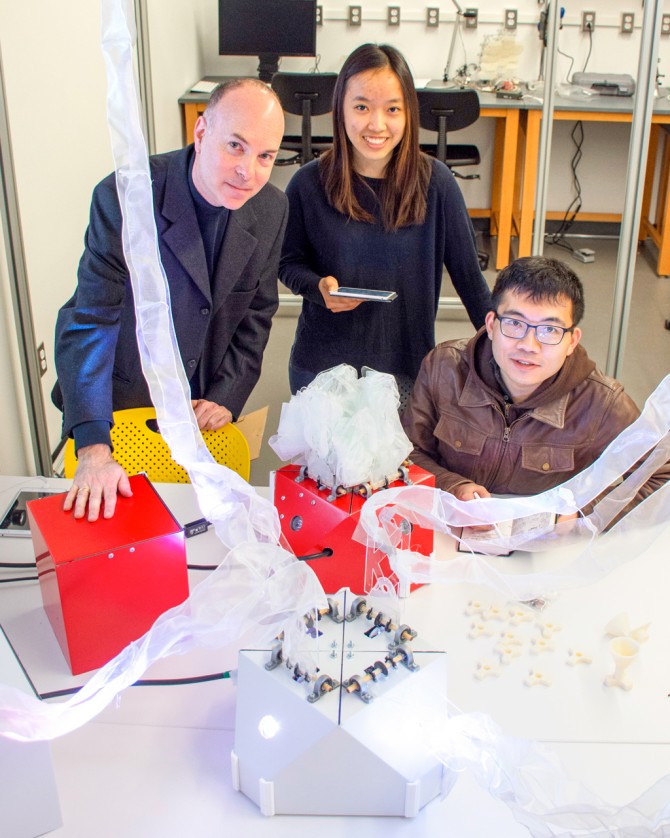Space-making ‘robot rooms’ promise practicality, escape
By James Dean, Cornell Chronicle
In millions of homes today, voice commands prompt “smart” devices to turn on lights, change the temperature or deliver weather forecasts, while robotic vacuums autonomously hunt for crumbs and dust bunnies.
But what if robots and computer intelligence weren’t just in the room – they were the room?
Supported by a new three-year, $600,000 National Science Foundation grant and an industry partner, Cornell researchers and collaborators are working on what they say is a next frontier in domestic human-machine interaction, a new category of space-making robots that people will inhabit.
Keith Evan Green, director of the Architectural Robotics Lab, calls them “robot rooms”: reconfigurable, intelligent environments that will surround and support people occupying small spaces, from high-rise studios and hospital rooms to self-driving vehicles and spacecraft.
“We’re working on a room of multiple robot surfaces that make one room, many rooms,” said Green, professor in the College of Human Ecology’s Department of Human Centered Design and the College of Engineering’s Sibley School of Mechanical and Aerospace Engineering. “But we can also create a space that transports you to another place psychologically, a portal to somewhere else.”
Writers, architects and technologists have imagined such spaces, but the new research plans to produce the first prototype – to be tested in a hotel room. Futuristic as it sounds, the work is driven by current population and lifestyle trends, some accelerated by the pandemic.
Green and longtime collaborator Ian Walker, professor of electrical and computer engineering at Clemson University, point to a pharmacy chain’s 2020 TV ad titled “Home is Everything,” which captured many families’ new reality that “all of a sudden, home is office and school, home is playground, gym and concert hall.”
The strain on homes to be “everything” is expected to continue as remote work becomes more common, and as people increasingly move to cities where living spaces are shrinking to accommodate growth.
“Prompted by climate change, a growing population, rapid urbanization, global pandemics and limited access to nature, there is an urgent need to rethink the design of domestic settings,” Green wrote in a recently published book chapter. “Looking to the future, we are preparing for the possibility of living in extreme environments on Earth and other planets.”
Several startups now offer systems of motorized furniture that, with the press of a button, moves back and forth, or up and down, to optimize space. Green and Walker are focused on a room’s envelope, advancing non-rigid, robotic surfaces embedded with sensors, controllers and some degree of intelligence. The work follows a series of NSF-funded projects led by Green over two decades that has developed potential robot room components. Some examples:
- The Animated Work Environment experimented with desks and wall panels that reconfigure to serve various needs. The researchers similarly envision robotic “space agents” rearranging within apartments or autonomous vehicles – in response to voice commands, gestures or perhaps intuitively – to create distinct areas for work, socializing or children’s play.
- Robotic side tables and lamps could help retrieve items from the floor or place objects on high shelves, supporting aging-in-place or residents with limited mobility – far less expensively than many proposed humanoid robots, Green said. Wall-climbing robots also could help organize and fetch items, from keys to medications.
- Hinting at robot rooms’ potential as portals, the LIT ROOM created an immersive environment to enhance scenes from books read aloud, supporting children’s literacy. Wall and ceiling surfaces could be programmed to change shape and color and emit sounds.
- More recently, Green’s lab has designed surfaces embedded with plant material, an idea that could incorporate nature into living spaces far removed from it and support residents’ well-being.
Supporting the research is The Gettys Group Companies, a family of hospitality and design enterprises that plans to host and help evaluate the prototype robot room within one of their hotels.
Co-founders Roger Hill ’87 and Andrew Fay ’87 are also among the founders of Hotel of Tomorrow, a global think tank envisioning the future of the hospitality industry. Hill and Fay imagine voice commands one day prompting furnishings to move or adjust so they’re easier to access, helping older adults travel independently for longer. Projection screens, biometric monitoring for environmental adjustments and other enhancements might facilitate a better night’s sleep or a more focused work setting.
“Keith’s passion for technology and thinking about how to create environments, including ones that are more friendly for people as they age, is just incredibly relevant,” Hill said. “As the overall population ages and hotel owners face continued concerns about workforce shortages, we anticipate that these innovations will address several of these operational challenges as well as enhance guest satisfaction. We think he’s on his way to doing something that’s going to be extremely significant to the industry.”
Determining what exactly a robot room should include and look like – how many robotic surfaces, where and for what purpose? – is a goal of the research. User experience studies and rapid prototyping will explore at least two real-world scenarios ripped from pandemic headlines: how to adapt a space to serve practical needs, and how to escape without leaving home.
Green, the author of a book that established the subfield of architectural robotics, said his goal as a designer is to harness for good the increasingly powerful and ubiquitous technologies shaping a “post-human” world.
“Robots are coming, and they’ll keep coming,” he said. “The question is, what can we do with them so that we have either less pain or a little bit more pleasure; so that we can work more efficiently or better together; so that we can better understand each other – and ourselves.”
Media Contact
Get Cornell news delivered right to your inbox.
Subscribe

